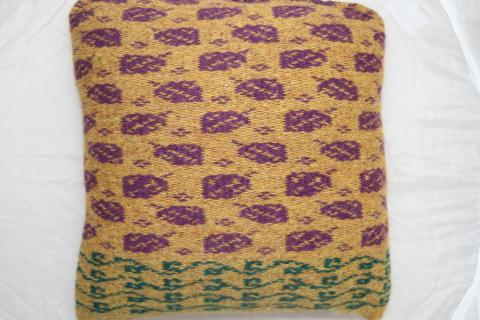Warp Yarn:
Organic Cotton
Sett:
10epi
Picks:
20ppi
Weft yarn:
2/11 wool
Notes:
Historical information
This entry was inspired by one of 3 patterned woven textiles were found in Gayet’s Antinoe excavations. These textiles were pillows placed under the heads of Romans in the cemetery (Becker). The 3 pillows found by Albert Gayet in Egyptian cemetery in Antinoe have been dated to the first half of the 3rd Century (Becker, Hoskins, Pritchard). A further 16 textiles were found as part of the EEF excavations from 1913-1914 (Prichard)
These textiles were dated according to burial methods in the find, the burial used painted coffin covers and sculpted plaster portraits (mummy masks, or cartonnages) (Becker & Hoskins).
These pillows were woven in taquete- a compound weft-faced plain weave. One pillow was woven with a pattern of blue leaves on a yellow background, red Greek frets on a white/natural background, blue wave motifs on a white/natural background, red Greek frets on a white/natural background, a green ivy pattern on a white/natural background, and another set of red Greek frets on a white/natural background. The weavers were careful to weave the textiles so as to be reversible, which is done when you ensure the plain areas are woven with the correct background colour. The back of the pillow was woven with a lozenge pattern in the natural weft colour (Becker & Hoskins).
However the pillows are designated as foreign imports. This determination was made because the pillows are woven in Z-spun woollen singles. Researchers agree that Egyptian weavers were using only S-spun yarn at this time. Becker, therefore attributed the pillows to Western Asian, likely Persian weavers, which makes this a great example for me to use, as a 7th C Persian weaver.
Technical details: (Becker & Hoskins)
Sett: 40 ends per inch (epi). Picks per inch (ppi): 44-48
Warp: Z spun wool singles Weft: Z spun wool singles, in natural, yellow, blue, red, and green.
Other examples of taquete in this period
Clothworkers Centre 899-1886 350-450 A.D. Woolen Taquete
Photo taken by me at the centre. I estimate the EPI: 20 PPI: 30
[[{"type":"media","view_mode":"media_large","fid":"161","field_deltas":{},"link_text":null,"attributes":{"height":320,"width":480,"class":"media-image media-element file-media-large","data-delta":"1"},"fields":{}}]]
<br>Photo by Erica J taken at the Clothworkers Centre.V^5hP*8uXfAd
<br>What I did</br>
I wove my pillow in purple, green, and yellow, because they are the colors of my heraldry and my personal preference. When weaving I believe you should weave for the preferences of the client, which was in this case myself. I used the pattern redrafted to require only 14 pattern shafts by Nancy Hoskins.
I used a sett of 10 epi, because this was the sett required for the materials I used. I used an organic cotton for the warp, which is a method used later than the Antinoe pillow, but not completely out of the realm of possibility in the 1st Century, but also more likely for the 7th C, which is my chosen period. Such as the later examples of taquete from Quseir al-Qadim, Fustat and Qasr Ibrim which used a cotton warp (Pritchard). Pritchard stated these speciality taquete fabrics were woven on into the Early Islamic Period (7th/8th C.) The back of this pillow was woven in weft faced tabby, rather than the lozenges, as this will be used for camp, not as a luxury item.
Warp: 18/2 Organic cotton
Weft: 12/2 wool yellow, purple, green S spun wool
Photo of the reverse of my cloth, note I took the same care as the original weavers to make my cloth reversible.
[[{"type":"media","view_mode":"media_large","fid":"160","field_deltas":{},"link_text":null,"attributes":{"height":480,"width":480,"class":"media-image media-element file-media-large","data-delta":"2"},"fields":{}}]]
Pillow construction
I was unable to obtain the original text where the in depth description of the pillow was given. I have therefore made, what I consider reasonable assumptions about the construction methods and stitches used. There are only 3 seams in a pillow, all of which take a fair amount of stress. I therefore used small back stitches to sew up the sides and the top seams. For the inside of the pillow, I used a small pillow we were not actually using took out the batting and used goose down feathers from another pillow that was not in use. I sewed up the sides of the pillow coverings, then sewed the inner pillow to be as large as would possible fit, for maximum comfort.
Use
This pillow can serve a variety of uses, but will likely spend much time cushioning my seat in camp, when it is not being used as a cushion it can be used as a decorative pillow on our bed.
Works Cited
Becker, John. (1987). Pattern and Loom. Rhodos International Publishers, Copenhagen.
Hoskins, N.A. (1992). Weft-Faced Pattern Weaves: Tabby to Taquete. University of Washington Press.
Pritchard, F. (2015) Soft-furnishing textiles from the Egypt Exploration Fund season at Antinoupolis, 1913–14. British Museum. London. http://www.britishmuseum.org/pdf/Pritchard.pdf
Notes
Weave Structure
Portfolio Images
Image

Cover Image
Image
